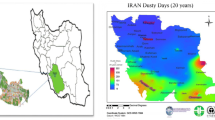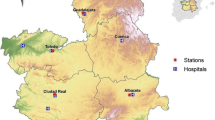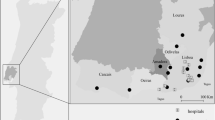Abstract
Previous studies suggest that human exposure to atmospheric pollution can trigger cardiovascular diseases (CVDs). This study aimed at assessing the influence of short-term exposure to atmospheric pollution in the occurrence of CVD and mortality in Madeira. A single-centre retrospective study was conducted during 2005–2011. Air pollutant data and meteorological parameters were gathered. Daily admissions at the emergency service due to CVD and markers levels for cardiac function were obtained from a public hospital. Exploratory and correlation analysis of all variables were performed, and the CVD relative risk (RR) of hospital admissions and mortality was calculated. During the study, mean annual concentrations of the air pollutants varied greatly, with NOx and O3 showing the highest annual average concentrations. Two hundred ten thousand five hundred forty patients were admitted at the emergency service, 74% of them due to cardiovascular causes. Hospital admissions were positively correlated with PM2.5, and SO2. A positive and significant association between PM2.5 with creatine kinase myocardial band and B-type natriuretic peptides markers was found, whilst SO2 was positively associated with Creatine kinase myocardial band. The RR seemed to increased with PM2.5 and NOx exposure. Traffic-related pollutants were weakly but statistically associated to hospital admissions due to CVD and mortality. PM2.5 and SO2 were related with higher hospital admissions which in turn seemed to increase the serum markers. The risk of mortality was mainly associated with O3 and average air temperature. Adults and elders seem to be more susceptible to atmospheric pollutants, particularly in the winter.





Similar content being viewed by others
References
Analitis, A., Katsouyanni, K., Biggeri, A., Baccini, M., Forsberg, B., & Bisanti, L. (2008). Effects of cold weather on mortality: Results from 15 European cities within the PHEWE project. American Journal of Epidemiology, 168(12), 1397–1408.
Archer, J. (2003). Cardiac biomarkers: A review. Comparative Clinical Pathology, 12(3), 121–128.
Azevedo, J. M., Gonçalves, F. T., & Andrade, M. F. (2011). Long-range ozone transport and its impact on respiratory and cardiovascular health in the north of Portugal. International Journal of Biometeorology, 55, 187–202.
Bartoš, V., Dastych, M., Dastych, M., Franek, T., Jirsa, M., Kalousová, M., et al. (2016). Clinical biochemistry (1st ed.). Prague: Karolinum Press.
Bodor, G. S. (2016). Biochemical markers of myocardial damage. Electronic Journal of the International Federation of Clinical Chemistry and Laboratory Medicine, 27(2), 95–111.
Bourdrel, T., Bind, M. A., Béjot, Y., Morel, O., & Argacha, J. (2017). Cardiovascular effects of air pollution. Archives of Cardiovascular Diseases, 110(11), 634–642.
Brame, G. R., & Childers Jr., W. A. (2011). Cardiac biomarkers: Current standards, future trends. Clinician Reviews, 21(10), 30–35.
Brook, R. D., Urch, B., Dvonch, J. T., Bard, R. L., Speck, M., Keeler, G., et al. (2009). Insights into the mechanisms and mediators of the effects of air pollution exposure on blood pressure and vascular function in healthy humans. Hypertension, 54, 659–667.
Cohen, A. J., Brauer, M., Burnett, R., Anderson, H., Frostad, J., Estep, K., et al. (2017). Estimates and 25-year trends of the global burden of disease attributable to ambient air pollution: An analysis of data from the Global Burden of Diseases Study 2015. Lancet, 389(10082), 1907–1918.
Dominici, F., McDermott, A., Zeger, S. L., & Samet, J. M. (2003). National maps of the effects of particulate matter on mortality: Exploring geographical variation. Environmental Health Perspectives, 111(1), 39–44.
European Environment Agency. (2013). Air quality in Europe – 2013 report (pp. 1–112). Luxembourg: Publications Office of the European Union, nº 9. https://www.eea.europa.eu/publications/air-quality-in-europe-2013. Accessed 10 Mar 2018.
European Environment Agency. (2016). Air quality in Europe – 2016 report (pp. 1–88). Luxembourg: Publications Office of the European Union, nº 28. https://www.eea.europa.eu//publications/air-quality-in-europe-2016. Accessed 10 Mar 2018.
European Commission Agency (2018). Air Quality Standards. http://ec.europa.eu/environment/air/quality/standards.html. Accessed 20 August 2018.
Fonseca, C., Brás, D., Araújo, I., & Ceia, F. (2018). Heart failure in numbers: Estimates for the 21st century in Portugal. Revista Portuguesa de Cardiologia, 37(2), 97–104.
Franklin, B. A., Brook, R., & Pope, C. A. (2015). Air pollution and cardiovascular disease. Current Problems in Cardiology, 40(5), 207–238.
Freitas, M. C., Pacheco, A. M., Verburg, T. G., & Wolterbeek, H. T. (2010). Effect of particulate matter, atmospheric gases, temperature, and humidity on respiratory and circulatory diseases' trends in Lisbon, Portugal. Environmental Monitoring and Assessment, 162(1–4), 113–121.
Gagliardi, A. C., Miname, M. H., & Santos, R. D. (2009). Uric acid: A marker of increased cardiovascular risk. Atherosclerosis, 202(1), 11–17.
Garg, P., Morris, P., Fazlanie, A. L., Vijayan, S., Dancso, B., Dastidar, A. G., et al. (2017). Cardiac biomarkers of acute coronary syndrome: From history to high-sensitivity cardiac troponin. Internal and Emergency Medicine, 12(2), 147–155.
Guerreiro, C. B., Foltescu, V., & Leeuw, F. (2014). Air quality status and trends in Europe. Atmospheric Environment, 98, 376–384.
Haberzettl, P. (2018). Circadian toxicity of environmental pollution. Inhalation of polluted air to give a precedente. Current Opinion in Physiology, 5, 16–24.
Hsu, W. H., Hwang, S. A., Kinney, P. L., & Lin, S. (2017). Seasonal and temperature modifications of the association between fine particulate air pollution and cardiovascular hospitalization in New York state. Science of the Total Environment, 578, 626–632.
Instituto Nacional de Estatística (2014). Risco de Morrer 2012. https://www.ine.pt/xportal/xmain?xpid=INE&xpgid=ine_publicacoes&PUBLICACOESpub_boui=216382393&PUBLICACOESmodo=2&xlang=pt. Accessed 18 August 2018.
Jayamurugan, R., Kumaravel, B., Palanivelraja, S., & Chockalingam, M. P. (2013). Influence of temperature, relative humidity and seasonal variability on ambient air quality in a coastal urban area. International Journal of Atmospheric Sciences. https://doi.org/10.1155/2013/264046.
Katsouyanni, K., Touloumi, G., Samoli, E., Gryparis, A., Le Tertre, A., Monopolis, Y., et al. (2001). Confounding and effect modification in the short-term effects of ambient particles on total mortality: Results from 29 European cities within the APHEA2 project. Epidemiology, 12(5), 521–531.
Laboratório Regional de Engenharia Civil. AREAM. Câmara Municipal do Funchal. (1996). Caso de estudo sobre poluição atmosférica Funchal. Projecto ISIS. http://aream.pt/files/2016/05/ISIS_Caso_estudo-AR.pdf. Accessed 10 Mar 2018.
Liu, Z., Hu, B., Wang, L., Wu, F., Gao, W., & Wang, Y. (2015). Seasonal and diurnal variation in particulate matter (PM10 and PM2.5) at an urban site of Beijing: Analyses from a 9-year study. Environmental Science and Pollution Research, 22(1), 627–642.
López-Villarrubia, E., Ballester, F., Iñiguez, C., & Peral, N. (2010). Air pollution and mortality in the Canary Islands: A time-series analysis. Environmental Health, 9, 8.
Madeira em Números. (2016). Direção Regional de Estatística da Madeira. Funchal: D.R.E.M. https://estatistica.madeira.gov.pt/download-now-3/multitematicas-gb/multitematicas-mn-gb/multitematicas-mn-publicacoes-gb/finish/213-madeira-em-numerospublicacoes/8729-madeira-em-numeros-2016.html. Accessed 18 Apr 2018.
Macedo, M., Lima, M. J., Silva, A. O., Alcantara, P., Ramalhinho, V., & Carmona, J. (2010). Prevalence, awareness, treatment and control of hypertension: The PAP study. Journal of Hypertension, 23(9), 1661–1666.
Mills, N. L., Donaldson, K., Hadoke, P. W., Boon, N. A., MacNee, W., Cassee, F. R., et al. (2009). Adverse cardiovascular effects of air pollution. Nature Clinical Practice Cardiovascular Medicine, 6, 36–44.
Moreira, C. S., Alcântara, P., & Nicolau, V. (2017). Insuficiência cardíaca e patologia associada em Portugal entre 2000 e 2005. Revista Portuguesa de Cardiologia, 36, 194.
Nebel, B. J., & Wright, R. T. (1993). Environmental science: The way the world works (4th ed.). New Jersey: Prentice Hall.
Newby, D. E., Mannucci, P. M., Tell, G. S., Baccarelli, A. A., Brook, R. D., Donaldson, L., et al. (2015). Expert position paper on air pollution and cardiovascular disease. European Heart Journal, 36(2), 83–93b.
Peters, A. (2005). Particulate matter and heart disease: Evidence from epidemiological studies. Toxicology and Applied Pharmacology, 207(2 Suppl), 477–482.
Peters, A., Dockery, D. W., Muller, J. E., & Mittleman, M. A. (2001). Increased particulate air pollution and the triggering of myocardial infarction. Circulation, 103(23), 2810–2815.
Peters, A., von Klot, S., Mittleman, M. A., Meisinger, C., Hormann, A., Kuch, B., et al. (2013). Triggering of acute myocardial infarction by different means of transportation. European Journal of Preventive Cardiology, 20, 750–758.
Pinheiro, S. A., Saldiva, P. H., Schwartz, J., & Zanobetti, A. (2014). Efeitos isolados e sinérgicos do MP10 e da temperatura média na mortalidade por doenças cardiovasculares e respiratórias. Revista de Saúde Pública, 48(6), 881–888.
Pope, C. A., Reunlund, D. G., Kfoury, A. G., May, H. T., & Horne, B. D. (2008). Relation of heart failure hospitalization to exposure to fine particulate air pollution. American Journal of Cardiology, 102(9), 1230–1234.
Querol, X. (2008). Calidad del aire, partículas en suspensión y metals. Revista Española de Salud Pública, 82, 447–454.
Querol, X., Alastuey, A., Pandolfi, M., Reche, C., Pérez, N., & Minguillón, M. C. (2014). 2001-2012 trends on air quality in Spain. Science of the Total Environment, 490, 957–969.
Rich, D. Q., Kipen, H. M., Zhang, J., Kamat, L., Wilson, A. C., & Kostis, J. B. (2010). Triggering of transmural infarctions, but not nontransmural infarctions, by ambient fine particles. Environmental Health Perspectives, 118, 1229–1234.
Schwartz, J. (2004). The effects of particulate air pollution on daily deaths: A multi-city case crossover analysis. International Journal of Occupational and Environmental Health, 61(12), 956–961.
Shah, A. S., Ferry, A. V., & Mills, N. L. (2017). Cardiac biomarkers and the diagnosis of myocardial infarction in women. Current Cardiology Reports, 19(5), 40.
Stähli, B. E., Gebhard, C., Yonekawa, K., Gebhard, C. E., Altwegg, L. A., von Eckardstein, A., et al. (2015). Gender-related differences in patients presenting with suspected acute coronary syndromes: Clinical presentation, biomarkers and diagnosis. Cardiology, 132(3), 189–198.
Strobel, N. A., Fassett, R. G., Marsh, S. A., & Coombes, J. S. (2011). Oxidative stress biomarkers as predictors of cardiovascular disease. International Journal of Cardiology, 147(2), 191–201.
Strunz, C. M., Araki, L. M., Nogueira, A., & Mansur, A. P. (2011). Gender differences in serum CK-MB mass levels in healthy Brazilian subjects. Brazilian Journal of Medical and Biological Research, 44(3), 236–239.
Sunyer, J., Ballester, F., Tertre, A. L., Atkinson, R., Ayres, J. G., & Forastiere, F. (2003). The association of daily sulfur dioxide air pollution levels with hospital admissions for cardiovascular diseases in Europe (The Aphea-II study). European Heart Journal, 24(8), 752–760.
Tadano, Y. S., Ugaya, C. M., & Franco, A. T. (2009). Método de regressão de Poisson: metodologia para avaliação do impacto da poluição atmosférica na saúde populacional. Ambiente & Sociedade, 12(2), 241–255.
Townsend, N., Nichols, M., Scarborough, P., & Rayner, M. (2015). Cardiovascular disease in Europe - epidemiological update 2015. European Heart Journal, 36(40), 2696–2705.
United States Environmental Protection Agency (2018). National Ambient Air Quality Standards Table. https://www.epa.gov/criteria-air-pollutants/naaqs-table. Accessed 13 August 2018.
Vasconcelos, J. (2012). Bioclima, saúde e qualidade da habitação em Portugal: Papel da exposição ao frio na incidência de doenças coronárias agudas. PhD Thesis, Faculdade de Ciências e Tecnologia e Universidade Nova de Lisboa.
Wilson, T. E., Gao, Z., Hess, K. L., & Monahan, K. (2010). Effect of aging on cardiac function during cold stress in humans. American journal of physiology. Regulatory, integrative and comparative physiology, 298(6), 1627–1633.
World Health Organization. (2016). WHO Expert Consultation: Available evidence for the future update of the WHO Global Air Quality Guidelines (AQGs) (pp. 1–50). WHO Regional Office for Europe. http://www.euro.who.int/__data/assets/pdf_file/0013/301720/Evidence-future-update-AQGs-mtg-report-Bonn-sept-oct-15.pdf?ua=1. Accessed 10 Aug 2018.
World Health Organization. (2018). Health risk assessment of air pollution – General principles (pp. 1–40). WHO Regional Office for Europe. http://www.euro.who.int/__data/assets/pdf_file/0006/298482/Health-risk-assessment-air-pollution-General-principles-en.pdf?ua=1. Accessed 10 Aug 2018.
Acknowledgements
A special thank to SESARAM’s Administration, to Dr. Fátima Teixeira, Dr. Ilídio Ornelas from the Hospital Dr. Nélio Mendonça, and also to Dr. Mónica Fernandez for the assistance in the statistical analysis. The authors are grateful to Doctor Cristiana Granito Camacho from the Hospital Dr. Nélio Mendonça for the proof reading and valuable comments.
Author information
Authors and Affiliations
Corresponding author
Ethics declarations
Conflict of Interests
The authors declare that they have no conflict of interest.
Additional information
Publisher’s Note
Springer Nature remains neutral with regard to jurisdictional claims in published maps and institutional affiliations.
Rights and permissions
About this article
Cite this article
Camacho, I., Camacho, J., Camacho, R. et al. Influence of Outdoor Air Pollution on Cardiovascular Diseases in Madeira (Portugal). Water Air Soil Pollut 231, 94 (2020). https://doi.org/10.1007/s11270-020-4430-4
Received:
Accepted:
Published:
DOI: https://doi.org/10.1007/s11270-020-4430-4




